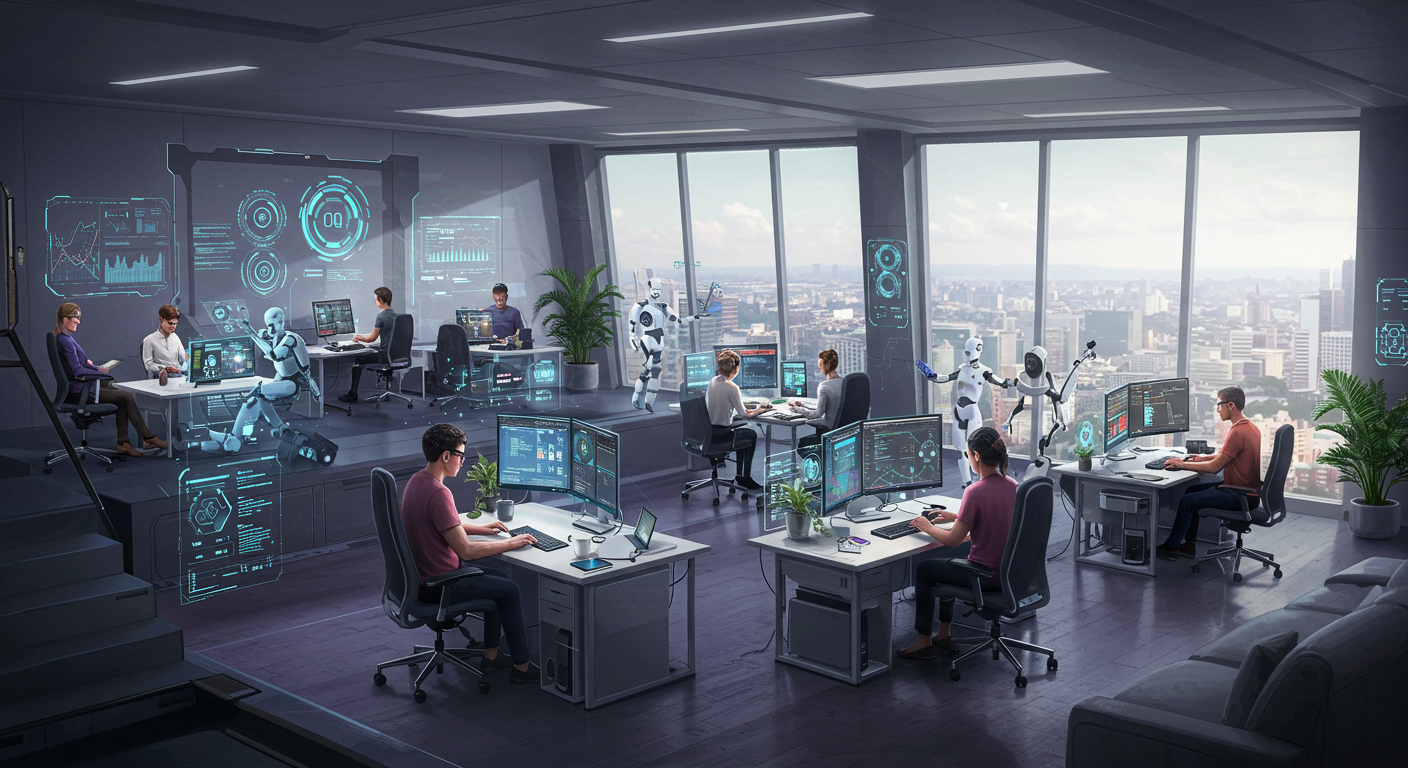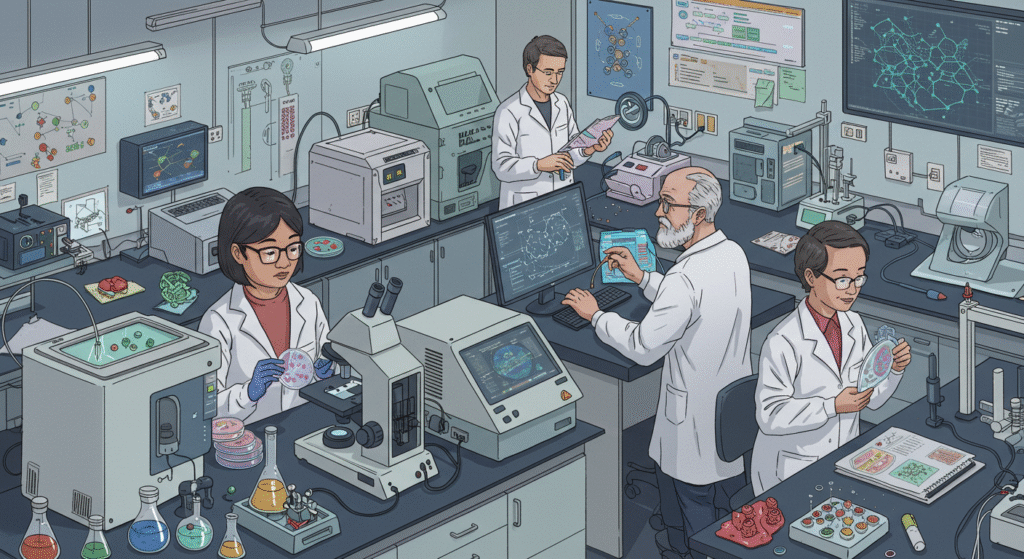
Two years later, rivers of ink are still flowing about how AI continues to transform and will continue to transform our society, its impact on work, and where future changes will go.
There are opinions and predictions of all kinds, but they all agree on one thing: the impact is huge, especially in how jobs with a high intellectual component are changing and will continue to change.
As always happens with great revolutions, and this one is very big, perhaps even bigger than the industrial revolution, this brings with it threats and opportunities.
And here is another important consensus that is crystallizing among all opinions: AI will not take away your job; it will be taken away from you by someone who knows how to use it better than you.
It’s time to get your act together. So in this article I will introduce you to 10 jobs, of which 3 are completely and the other 7 change so much because of the impact of AI that it is as if they were.
On the other hand, all these jobs can be carried out, at least partially, from home, a trend that continues to be consolidated worldwide.

Can you imagine having a profession that didn’t even exist a decade ago? AI has not only transformed existing jobs, but it has also brought entirely new jobs to life.
These jobs are at the forefront of technology, combining creativity, analysis, and a deep understanding of AI. They are perfect for those who are looking for new challenges and want to be pioneers in their fields.
Prompt engineering (and you don’t know what a prompt is yet; it’s already taking a while…) is an emerging and rapidly growing field that is giving a lot to talk about.
But what exactly does it consist of?
Well, it’s about creating carefully optimized instructions for artificial intelligence tools such as ChatGPT or DALL-E.
The goal is to get these AIs to generate answers that are as accurate and relevant as possible. In other words, being able to optimize a prompt to get the best possible response from an AI.
And who can dedicate themselves to this?
Although it is a new discipline, it fits very well with a wide range of profiles: software developers, data scientists, or linguists have a lot to contribute in this field.
But, what’s more, anyone with an alert mind and a good sense of logic fits.
Why?
Because it is new, there are very few experts, and the main skills are knowledge of natural language processing and content writing, a field in which a large number of people should be able to train without major problems.
And you don’t need to be an expert to start being productive, and it’s easy to train given the large amount of material available. In fact, OpenAI itself offers a free prompt engineering course.
It is an excellent way to take your first steps in this new profession in which the demand for prompt engineers does not stop growing.

Until recently, chatbots have been little more than toys and often even annoyed rather than helped. But this, with the technology on which ChatGPT is based, has also changed radically.
A new generation of products is able to serve customers with the same capacity and competence as a human, sometimes even better.
So much so that the most innovative companies have already replaced entire operator templates with AI tools after carrying out pilots in which AI not only rose to the occasion but even surpassed human performance.
In addition, this technology is not only available to large companies but also to small ones, even self-employed workers who can be offered the creation of AI-based business assistants.
The effort to create simple but already very effective solutions is reduced, and the cost of operation is even more so.
So, if you work in app development, look at this field as a service line to include in your portfolio. And if you are an operator, get used to the idea that you must assume as soon as possible that your profession has suffered a total disruption and that it is time to recycle.
An excellent way to recycle yourself may be precisely to learn how to build this type of chatbot. Combined with your real experience in the field, it’s a very valuable combination that many companies in the field will know how to value.

As Wikipedia cites, biological engineering, or bioengineering, “is a discipline that applies physical-mathematical concepts and methods to solve problems in the life sciences, using the analytical and synthetic methodologies of engineering.”
This discipline is revolutionizing the way we approach medical research and treatment development.
Within this revolution, AI has created its own revolution since it allows huge sets of biological data to be analyzed. And this allows you to discover patterns and connections that would be impossible to detect with traditional methods.
One of the most important areas of application is the development of new medical treatments.
Using AI and machine learning, researchers can simulate and predict the efficacy of new drugs, significantly accelerating the discovery process.
To date, the development of new proteins that could be used, for example, for cancer drugs, was done to a large extent by researching and discovering why fundamental properties such as the folding of new molecules could not be predicted.
Here, with AIs such as Chai-1 and Alpha Proteo, for example, the step has been taken to be able to design proteins with the desired properties; that is, we have gone from searching and discovering to engineering.
Professionals in this field need a strong foundation in molecular biology, genetics, and bioinformatics, combined with skills in programming and data analysis.
The demand for experts in this area is growing rapidly, offering great opportunities at this intersection of science and technology.
AI is not only creating new jobs; it is also profoundly transforming many traditional professions. If you already have experience in any of these fields, it’s time to learn how AI is redefining your work.
These transformations offer exciting opportunities to improve your efficiency, expand your capabilities, and address challenges in innovative ways. Far from replacing humans, AI is becoming a powerful tool that enhances our abilities.
Learn how these seven jobs are evolving thanks to AI. Are you ready to adapt and stand out in the age of artificial intelligence?

One of the most obvious impacts, from day one, of the appearance of ChatGPT was the impact on content creation.
There was a huge content creation market, with a lot of really mediocre “professionals.” This type of profile can not only be completely replaced with AI, but the results will be better.
However, above all, in order to position yourself on Google, it is not a good idea to generate content “out of the box” with AI without further ado. It is not mainly for two reasons:
Does that mean that, in the end, when it comes to creating web content, AI is useless?
Not at all. I’ll explain why with two clear examples:
AI well used greatly accelerates the speed of content creation with an appropriate strategy, such as, for example, simply a good division into steps (first generate a structure, review and touch it up, generate individual sections with specification prompts, review and retouch those sections, etc.).
In fact, this same article has followed this process.
The key is not to make the mistake that 90% of people make: a single prompt that directly asks for the final result and pass it on as it is with copy & paste to the website.
The second reason applies to the quality and creativity of the content. It is almost certain that, in non-trivial content, in a previous exploration, the AI will find ideas that did not open up to you, at least, not immediately.
In addition, another area that was traditionally much more difficult to address for non-professionals in the profession is graphic design and particular image creation.
With AI, you’re not going to become a professional designer, but thanks to AI and tools such as Canva’s tools to enhance images with AI, the barrier to being able to do graphic work does fall a lot.

As I said before in the section on chatbots, if you work as a telemarketer, you must assume as soon as possible that your profession has suffered a total disruption, as demonstrated, for example, by the case of the fintech Klarna that I mentioned before, where almost overnight some 700 workers were successfully replaced by an AI.
But the potential and penetration of AI are much broader and extend to practically all customer service. For now, chatbots and virtual assistants have been implemented to handle the simplest queries, but the technology already exists to tackle more complex tasks.
Its implementation is more of a psychological barrier than a technical one, but it is clear that this implementation will come massively, and sooner rather than later.
There are several ways to deal with this situation: on the one hand, by focusing on developing skills that machines cannot yet replicate effectively, such as your emotional intelligence to handle delicate and complex situations.
But, in any case, the best insurance to remain competitive in this sector is an attitude of embracing AI to detect those points in which it can make you a better professional or turn to a different role, from customer service to consulting work in the redesign of this type of process.

Artificial intelligence (AI) has already revolutionized language teaching and translation.
The fundamental challenge you face is that we have already reached the point where the basic work of translating and teaching languages can already be done really well by machines.
And it won’t take long for us to get to the point where they’ll do much better than the average professional.
Therefore, competing exclusively in this field with AI is not a good strategy.
The strategy is again to try to find those twists and turns that you can give to your activity to “stay in the gap” in which the human factor is an added value that is difficult to replace.
In the case of teachers, this means moving towards a task with a greater component of management and direction of learning activities:
In the case of translators:
What challenges do you face?
In short, the use of AI in text translation means a brutal increase in productivity. However, human judgment, creativity, and cultural sensitivity, today, are still indispensable and areas in which people can do better than AIs.

The legal and consulting services industry is one of those industries where it might seem less obvious that there would be a significant impact from AI. However, the reality is the opposite: the impact has been enormous.
The ability of AI alone to quickly analyze large volumes of legal documents and case law has changed the dynamics of work completely, given the weight that this type of work has on a day-to-day basis, especially in the legal profession.
But there are many other facets, such as:
The challenges we encounter here include:
In this sense, AI is streamlining many aspects of legal work, allowing professionals to focus on tasks that require complex reasoning, empathy, and strategy.
However, human expertise remains crucial for interpreting laws, arguing in court, and providing personalized advice to clients.
However, the number of routine and low-value-added tasks, such as the study of exhaustive documentation or consulting at a basic level, that AI can practically eliminate has simply been enormous.

Artificial intelligence (AI) is redefining the role of the data analyst, offering powerful tools to process, analyze, and visualize large volumes of information in an unassisted, more efficient, and effective way.
AI algorithms are able to cleanse, structure, and prepare data faster and more accurately, and machine learning models identify complex patterns and make more accurate predictions.
These strengths are especially pronounced in unstructured text and natural language analysis, such as customer feedback or reports.
And in addition, AI tools are also capable of suggesting the best ways to visually represent data and insights.
AI’s proficiency in these tasks, coupled with the volume of data it can process and the speed at which it is able to do so, has led to new capabilities that were previously much more costly and inaccurate:
But of course, here too professionals encounter new challenges:
However, this field is also an example, especially of how, with the right change of perspective, the human professional can continue to provide a lot of added value:
And, as in the other fields presented here, we can see that the role of AI is focused on taking care of the most tedious and routine tasks, freeing up time for the data analyst that allows them to focus much more on tasks of greater strategic and creative value.

In development in general, and in web development in particular, AI has turned out to be especially “talented.” Particularly LLMs (large language models), AIs are really good at programming.
This is something that has taken developers themselves by surprise because the development of complex programs and algorithms has traditionally been one of the intellectual tasks par excellence, and, in that sense, even by the technicians themselves (not experts in AI), it has been seen as something difficult or even impossible to be assumed by machines.
However, in just a few years, the capabilities of these models have gone from being toys to being absolutely impressive.
To the point that, with the help of an AI and without knowing anything about programming, even “normal” people can perform complex programming jobs such as the creation of video games.
At the moment, AIs managed by a non-technical person “only” manage to generate simple video games, but even so, they are still a significant programming challenge.
What specific things can AIs do in programming?
And here the challenges are also similar to those of the previous points, mainly:
In short, we can say that AI is reaching levels where it is close to being able to completely replace the classic role of analyst programmer. Today, the only thing it lacks is the autonomy of a human to follow its path.
In any case, the ability to enhance the capabilities of web developers and accelerate developments at this time is already tremendous.
Where it does not reach is to cover the management of non-trivial projects. For now, this is something that is beyond the reach of AIs, although with the development of agents, of which we will see a first batch shortly (in a year or a year and a bit), we will see how long this remains so.
Therefore, looking to the future of this profession, what must be clear is that the developer profile is gravitating much more towards what would currently be a project manager, where their skills, more than in the detailed analysis and development of the code, have to be focused on:
And a final implication, although this is already a personal opinion of mine, is that AI is going to greatly level the competitiveness of small developers (freelancers and small companies) with medium and large companies in the sector.
The “leverage effect” of people who know how to take advantage of the brutal increase in productivity of well-used AI means that a very small team of brilliant people (3 or 4) or even a single person can compete with, even surpass, a team of dozens of mediocre people.
Watch out for the latter; here is a great opportunity for small professionals to “pupa” their competition in large companies.
“Traditional” audiovisual producers are dedicated to implementing and managing projects that create visual, auditory, musical, or written content.
And this is where the advances of AI in the multimedia field come in, which are being, if possible, even more spectacular than in text generation.
In the area of images, we have authentic art generators such as Midjourney and DALL·E, capable of producing unique graphics and visuals from just a text description.
For video production, tools like Runway and Synthesia allow you to automatically generate realistic clips and animations, using AI technology to bring your ideas to life.
Audio and music production benefit greatly from today’s AI. With generators such as Suno or AIVA (Artificial Intelligence Virtual Artist), it is now possible to compose musical pieces adapted to different genres and styles that a “normal” person cannot differentiate from compositions created by humans.
On the other hand, for the creation of voice and sound, tools such as Descript and Resemble AI allow you to edit, synthesize, and manipulate human voices, bringing characters and narratives to life in different formats.
A prominent example of the application of AI in audiovisual production is NotebookLM.
This tool allows you to create automatic summaries of uploaded material in different formats, including a “podcast” style with two speakers, and the result is spectacular.
This last example seems to me to be especially illustrative of the paradigm of change that we are experiencing to the extent that it goes so far, to the point that it questions the traditional relationship between content products and reader.
Now, the reader can produce content of all kinds and of high quality tailored to their needs and tastes.
This does not mean that there is no room for audiovisual production, but of course, it will be very difficult to compete in the future with the traditional way of things, and the added value of this profession will revolve much more towards the creativity of the projects than the material production process that in a short time AI will be able to assume almost 100%.
This change is so radical that it makes this profession almost completely new; in fact, I have been very tempted to include it in the first section.
All of the above jobs are examples of jobs that can be easily converted to remote work and that, in many cases, already are.
But there are also other jobs that, by their nature, are difficult to do outside of the office but that are also examples of important current jobs that AI has had a full impact on, and that is why I wanted to include them in this article.
Artificial intelligence (AI) is revolutionizing medical practice in primary care and internal medicine, offering new tools to improve the diagnosis, treatment, and monitoring of patients.
For primary care physicians:
For internists:
On the challenge side, we have:
AI is empowering doctors’ ability to deliver more precise and personalized care. However, the clinician’s clinical judgment, experience, and empathy are still critical.
AI is positioned as a support tool, not a replacement, in complex medical decision-making and comprehensive patient care.
In the healthcare field, AI is revolutionizing medical image analysis. As a radiologist, you will no longer need to interpret images yourself; you will use AI to detect patterns and anomalies faster and more accurately with AI applications such as Aidoc.
These applications identify abnormalities in medical images, such as lung nodules, fractures, or tumors, and allow the prioritization of cases through systems that classify studies by urgency, allowing the most critical cases to be attended to first.
They do this through quantitative analysis with accurate and automatic measurements of volumes, densities, and other parameters in 3D images and comparison with previous studies where AI detects subtle changes between current and previous examinations of the same patient.
But, in addition, AI makes it possible to enhance current diagnostic imaging technologies with
What are the challenges in this case?
In short, AI is already capable of replacing the radiologist in “fieldwork”; however, expertise is still crucial for contextual interpretation, handling complex cases, and effective communication with other doctors and patients.
Therefore, this is the perspective with which professionals in this sector have to focus their careers from now on, focusing, above all, on tasks with greater added value that improve the general quality of patient care.

Artificial intelligence has not only created new professions, but it has also transformed existing jobs. Adapting to these trends is key to making the most of the opportunities of the digital world.
Many people perceive AI as a professional threat, and it is true that the way many professions work has become obsolete almost overnight.
You can embrace the AI or resist, but be clear that if you choose the latter, the AI will go over it.
However, if you know how to take advantage of it, you can take a giant step forward in your profession.

We’re here to help you strategize, grow, and achieve unparalleled success for your business. Let’s make it happen together!

Accelerating growth with creative digital marketing strategies designed to enhance brand visibility, boost engagement, and drive sustained conversions for long-term success.
© Copyright 2025 Lineesh – All Rights Reserved.